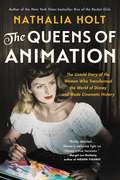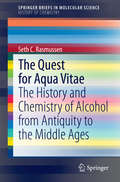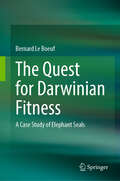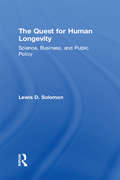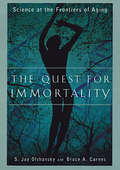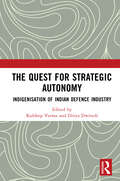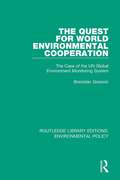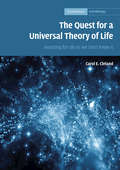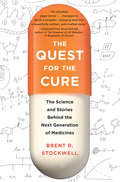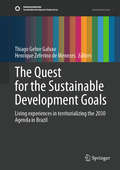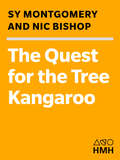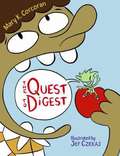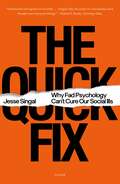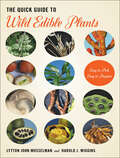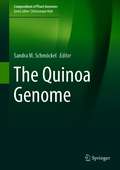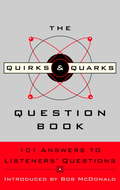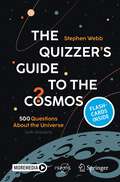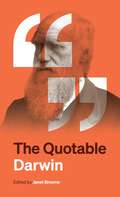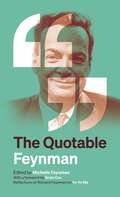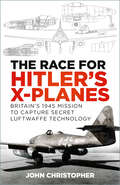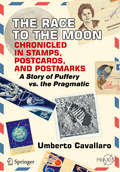- Table View
- List View
The Queens of Animation: The Untold Story of the Women Who Transformed the World of Disney and Made Cinematic History
by Nathalia HoltFrom the bestselling author of Rise of the Rocket Girls, the untold, "richly detailed" story of the women of Walt Disney Studios, who shaped the iconic films that have enthralled generations (Margot Lee Shetterly, New York Times bestselling author of Hidden Figures) From Snow White to Moana, from Pinocchio to Frozen, the animated films of Walt Disney Studios have moved and entertained millions. But few fans know that behind these groundbreaking features was an incredibly influential group of women who fought for respect in an often ruthless male-dominated industry and who have slipped under the radar for decades. In The Queens of Animation, bestselling author Nathalia Holt tells their dramatic stories for the first time, showing how these women infiltrated the boys' club of Disney's story and animation departments and used early technologies to create the rich artwork and unforgettable narratives that have become part of the American canon. As the influence of Walt Disney Studios grew---and while battling sexism, domestic abuse, and workplace intimidation---these women also fought to transform the way female characters are depicted to young audiences.With gripping storytelling, and based on extensive interviews and exclusive access to archival and personal documents, The Queens of Animation reveals the vital contributions these women made to Disney's Golden Age and their continued impact on animated filmmaking, culminating in the record-shattering Frozen, Disney's first female-directed full-length feature film.
The Quest for Aqua Vitae
by Seth C. RasmussenEthyl alcohol, or ethanol, is one of the most ubiquitous chemical compounds in the history of the chemical sciences. The generation of alcohol via fermentation is also one of the oldest forms of chemical technology, with the production of fermented beverages such as mead, beer and wine predating the smelting of metals. By the 12th century, the ability to isolate alcohol from wine had moved this chemical species from a simple component of alcoholic beverages to both a new medicine and a powerful new solvent. Of course, this also began the long tradition of production of liqueurs and strong spirits for consumption. The use of alcohol as a fuel, however, did not occur until significantly later periods. This volume presents a general overview of the early history and chemistry of alcohol production and isolation, as well as a discussion of its early uses in both the chemical arts and medicine.
The Quest for Darwinian Fitness: A Case Study of Elephant Seals
by Bernard Le BoeufThe mating game plays a central role in promoting individual biological fitness, but many other life-history traits (physical, physiological, and behavioral) also influence fitness. This book is about the optimal method for measuring biological fitness in mammals. This involves measuring lifetime reproductive success of individuals that survive to breeding age while living freely in nature. Constant monitoring of individuals is required, which explains why such studies are difficult to conduct and rare. I use a long-term study of extremely polygynous northern elephant seals (over 62 continuous years) to illustrate the necessary operations, benefits, pitfalls, and difficulties in conducting such studies. The aim of this treatise is to inform and facilitate future investigations of other animals. The Quest for Darwinian Fitness: Case Studies of Elephant Seals is a long-term study of the lifetime reproductive success of individuals, a practical approach to determining biological fitness. This case study is based on an animal that has been studied intensively. The aim of this chronicle is to facilitate the future long-term of other animals.
The Quest for Human Longevity: Science, Business, and Public Policy
by Lewis D. Solomon"Many scientists today are working to retard the aging process in humans so as to increase both life expectancy and the quality of life. Over the past decade impressive results have been achieved in targeting the mechanisms and pathways of aging. In The Quest for Human Longevity, Lewis D. Solomon considers these scientific studies by exploring the principal biomedical anti-aging techniques. The book also considers cutting edge research on mental enhancements and assesses the scientific doubts of skeptics. The Quest for Human Longevity is also about business. Solomon examines eight corporations pursuing various age-related interventions, profiling their scientific founders and top executives, and examining personnel, intellectual property, and financing for each firm. Academic scientists form the link between research and commerce. Solomon notes that the involvement of university scientists and researchers follows one of two models. The first is a traditional model in which scientists leave academia to work for a corporation or remain in academia and obtain business support for their research. The second is a modern model in which scientists use their intellectual property as a catalyst for acquiring equity interests in the firms they organize. Critics have pointed to the dangers of commercialized science, but Solomon's analysis, on balance, finds that the benefits outweigh the costs and that problems of secrecy and conflicts of interest can be addressed. If scientists succeed in unlocking the secrets of aging and developing drugs or therapies that will allow us to live decades longer, the consequences for society will include profound social, political, economic, and ethical questions. Solomon deals with the public policy aspects of significant life extension and looks at the conflict between those who advocate the acceptance of mortality and the partisans of life. The Quest for Human Longevity will be of interest to policymakers, sociologists, scientists, and studen"
The Quest for Immortality: Science at the Frontiers of Aging
by Bruce A. Carnes S. Jay Olshansky"This is by far the best book I've read on the science of aging."--Andrew Weil, M.D. "Life-span Truth Will Set You Free from Age-old Worries," announced the Chicago Tribune upon the first publication of this book. The New England Journal of Medicine confirmed, "For readers interested in aging and longevity, this small book clearly explains the major concepts...extremely enjoyable to read." From NBC Nightly News with Tom Brokaw to Scientific American to the New York Times, S. Jay Olshansky and Bruce A. Carnes have stirred up controversy and brought clarity to an issue often muddled by exaggeration and pseudoscience. Medical science has uncovered a host of answers to the problems of aging, but many of the most exciting discoveries are buried in scientific journals or overshadowed by popular quick-fix treatments. The Quest for Immortality explains the real science of aging and shows which treatments offered by today's multi-billion-dollar anti-aging industries offer real hope, and which are a waste of money and time.
The Quest for Strategic Autonomy: Indigenisation of Indian Defence Industry
by Divya Dwivedi Kuldeep Verma Js SodhiThis book offers insights into India’s efforts to become self-reliant in its defence sector. Encompassing a wide range of subjects – such as policy frameworks, technological advancements, economic considerations, and strategic implications – the subject matter explores the diverse aspects of India’s defence industry indigenisation efforts. By gathering the insights of esteemed experts, scholars, and professors, the book also presents an examination of the obstacles and possibilities in this process.The aim of this book is to contribute to the ongoing discussion on the importance of a robust domestic defence industry in strengthening India’s national security, elevating its international standing, and reinforcing its ability to make independent strategic decisions.Print edition not for sale in South Asia (India, Sri Lanka, Nepal, Bangladesh, Pakistan and Bhutan)
The Quest for World Environmental Cooperation: The Case of the UN Global Environment Monitoring System (Routledge Library Editions: Environmental Policy #8)
by Branislav GosovicFirst published in 1992. In 1972, the UN Conference on the Human Environment initiated the process of world environmental cooperation. This study is about GEMS (the Global Environment Monitoring System) which the Conference recommended be set up to generate data and information necessary for worldwide environmental assessment. This book examines the genesis and evolution of GEMS, and the complex task involved in establishing GEMS and making it perform its functions. It relates GEMS to the factors which have shaped the international environmental agenda and cooperation since 1972. In particular, it highlights North-South differences and the problems inherent in the international organizations belonging to the UN system, vis-á-vis the novel and multifaceted challenges involved in dealing with systemic, cross-sectoral nature of global environmental problems. The lessons of GEMS and other issues presented in this book are highly relevant to the continuing efforts to set up effective programmes for ‘earthwatching’ and to promote international environmental cooperation. They also relate more broadly to the challenges of managing global interdependence and to the need to devise supporting organizational structures through reform and strengthening of the UN system. The comprehensive nature of the political and institutional analyses presented in this book make it an academic reference work of lasting value. Its frank tone and willingness to derive prescriptive conclusions will appeal in particular to the many actors engaged in the processes and structures of global multilateral cooperation. The book will be of special use to those interested in environmental issues and international organization
The Quest for a Universal Theory of Life: Searching for Life As We Don't Know It (Cambridge Astrobiology #11)
by Carol E. ClelandIntegrating both scientific and philosophical perspectives, this book provides an informed analysis of the challenges of formulating a universal theory of life. Among the issues discussed are crucial differences between definitions and scientific theories and, in the context of examples from the history of science, how successful general theories develop. The central problem discussed is two-fold: first, our understanding of life is still tacitly wedded to an antiquated Aristotelian framework for biology; and second, there are compelling reasons for considering that familiar Earth life, which descends from a last universal common ancestor, is unrepresentative. What is needed are examples of life as we don't know it. Potential sources are evaluated, including artificial life, extraterrestrial life, and a shadow biosphere right here on Earth, and a novel strategy for searching for unfamiliar life in the absence of a definition or general theory is developed. The book is a valuable resource for graduate students and researchers studying the nature, origins, and extent of life in the universe.
The Quest for the Cure: The Science and Stories Behind the Next Generation of Medicines
by Brent StockwellAfter more than fifty years of blockbuster drug development, skeptics are beginning to fear we are reaching the end of drug discovery to combat major diseases. In this engaging book, Brent R. Stockwell, a leading researcher in the exciting new science of chemical biology, describes this dilemma and the powerful techniques that may bring drug research into the twenty-first century.Filled with absorbing stories of breakthroughs, this book begins with the scientific achievements of the twentieth century that led to today's drug innovations. We learn how the invention of mustard gas in World War I led to early anti-cancer agents and how the efforts to decode the human genome might lead to new approaches in drug design. Stockwell then turns to the seemingly incurable diseases we face today, such as Alzheimer's, many cancers, and others with no truly effective medicines, and details the cellular and molecular barriers thwarting scientists equipped with only the tools of traditional pharmaceutical research. Scientists such as Stockwell are now developing methods to combat these complexities-technologies for constructing and testing millions of drug candidates, sophisticated computational modeling, and entirely new classes of drug molecules-all with an eye toward solving the most profound mysteries of living systems and finding cures for intractable diseases. If successful, these methods will unlock a vast terrain of untapped drug targets that could lead to a bounty of breakthrough medicines. Offering a rare, behind-the-scenes look at this cutting-edge research, The Quest for the Cure tells a thrilling story of science, persistence, and the quest to develop a new generation of cures.
The Quest for the Sustainable Development Goals: Living experiences in territorializing the 2030 Agenda in Brazil (Sustainable Development Goals Series)
by Thiago Gehre Galvao Henrique Zeferino de MenezesThe book presents the experiences, complexities, and contradictions of the implementation of the Sustainable Development Goals in Brazil so far. Through chapters from a variety of stakeholders, the book examines national, regional, and local aspects of development in Brazil. The chapters here draw from scientific knowledge and practical experience to take a critical look at what the SDGs mean in a Global South country and what the implications of this are for global development. The book is divided into three sections. The first section addresses the critical political and institutional aspects related to the implementation of the Sustainable Development Goals in Brazil, highlighting advances as well as pitfalls and setbacks. The chapters look at broad questions related to the role of civil society in defining political priorities and strategies to move forward with the SDGs as well as issues involved in incorporating the SDGs at different levels of government and other institutions. The chapters in this section critically address the political and institutional advances as well as barriers to the progress of the SDGs in Brazil. The second section directly addresses progress made toward the SDGs in the context of the political, economic and social variables specific to Brazil. The chapters address critical shortcomings and demands for Brazilian society: the need for improvements in education and employment policies to reduce poverty, the urgent need to increase gender equality and reduce violence, as well as the imperative to strengthen institutions and policies to mitigate climate change and protect the environment. The final section focuses on critically assessing the 2030 Agenda itself and drawing from a Global South IR perspective. The chapters here dialog with decolonial and post-developmentalist perspectives to highlight problems with the agenda and lift up sidelined priorities, presenting yet-unexamined policy solutions and innovations that are currently absent from the global institutional agenda. The Brazilian case is a perfect illustration of how underdevelopment and political instability can constrain the paths to sustainable development, while at the same time social innovations, leverages based on regional dynamics, and strength from social and cultural diversity can drive sustained progress.
The Quest for the Tree Kangaroo: An Expedition to the Cloud Forest of New Guinea (Scientists in the Field Series)
by Sy Montgomery Nic Bishop<P>It looks like a bear, but isn't one. It climbs trees as easily as a monkey- but isn't a monkey, either. It has a belly pocket like a kangaroo, but what's a kangaroo doing up a tree? Meet the amazing Matschie's tree kangaroo, who makes its home in the ancient trees of Papua New Guinea's cloud forest. And meet the amazing scientists who track these elusive animals. <P>[This text is listed as an example that meets Common Core Standards in English language arts in grades 4-5 at http://www.corestandards.org.] <P><P> Winner of the Sibert Honor
The Quick Fix: Why Fad Psychology Can't Cure Our Social Ills
by Jesse SingalAn investigative journalist exposes the many holes in today’s bestselling behavioral science, and argues that the trendy, TED-Talk-friendly psychological interventions that are so in vogue at the moment will never be enough to truly address social injustice and inequality.With their viral TED talks, bestselling books, and counter-intuitive remedies for complicated problems, psychologists and other social scientists have become the reigning thinkers of our time. Grit and “power posing” promised to help overcome entrenched inequalities in schools and the workplace; the Army spent hundreds of millions of dollars on a positive psychology intervention geared at preventing PTSD in its combat soldiers; and the implicit association test swept the nation on the strength of the claim that it can reveal unconscious biases and reduce racism in police departments and human resources departments. But what if much of the science underlying these blockbuster ideas is dubious or fallacious? What if Americans’ longstanding preference for simplistic self-help platitudes is exerting a pernicious influence on the way behavioral science is communicated and even funded, leading respected academics and the media astray? In The Quick Fix, Jesse Singal examines the most influential ideas of recent decades and the shaky science that supports them. He begins with the California legislator who introduced self-esteem into classrooms around the country in the 1980s and the Princeton political scientist who warned of an epidemic of youthful “superpredators” in the 1990s. In both cases, a much-touted idea had little basis in reality, but had a massive impact. Turning toward the explosive popularity of 21st-century social psychology, Singal examines the misleading appeal of entertaining lab results and critiques the idea that subtle unconscious cues shape our behavior. As he shows, today’s popular behavioral science emphasizes repairing, improving, and optimizing individuals rather than truly understanding and confronting the larger structural forces that drive social ills. Like Anand Giridharadas’s Winners Take All, The Quick Fix is a fresh and powerful indictment of the thought leaders and influencers who cut corners as they sell the public half-baked solutions to problems that deserve more serious treatment.
The Quick Guide to Wild Edible Plants: Easy to Pick, Easy to Prepare
by Lytton John Musselman Harold J. WigginsField-to-table cuisine! Connect with (and eat) the diverse flora around us.A recent rise in the popularity of urban farming, farmers’ markets, and foraging from nature means more people are looking for information about plants. In The Quick Guide to Wild Edible Plants, botanists Lytton John Musselman and Harold J. Wiggins coach you on how to safely identify, gather, and prepare delicious dishes from readily available plants—and clearly indicate which ones to avoid.More than 200 color illustrations, accompanied by detailed descriptions, will help you recognize edible plants such as nettles, daylilies, river oats, and tearthumbs. For decades, Musselman and Wiggins have taught courses on how to prepare local plants, and their field-to-table recipes require only a few, easily found ingredients. They offer instructions for making garlic powder out of field garlic and turning acorns into flour for Rappahannock Acorn Cakes. To toast your new skill, they even include recipes for cordials. The Quick Guide to Wild Edible Plants is a great gift for the beginning naturalist and the perfect addition to every serious forager’s library.
The Quinoa Genome (Compendium of Plant Genomes)
by Sandra M. SchmöckelThis book focuses on quinoa, providing background information on its history, summarizing recent genetic and genomic advances, and offering directions for future research. Meeting the caloric and nutritional demands of our growing population will not only require increases in overall food production, but also the development of new crops that can be grown sustainably in agricultural environments that are increasingly susceptible to degradation. Quinoa is an ancient crop native to the Andean region of South America that has recently gained international attention because its seeds are high in protein, particularly in essential amino acids. Quinoa is also highly tolerant of abiotic stresses, including drought, frost and salinity. For these reasons, quinoa has the potential to help address issues of food security – a potential that was recognized when the United Nations declared 2013 the International Year of Quinoa. However, more effort is needed to improve quinoa agronomically and to understand the mechanisms of its abiotic stress tolerance; the recent development of genetic and genomic tools, including a reference genome sequence, will now help accelerate research in these areas.
The Quintessence of Basic and Clinical Research and Scientific Publishing
by Gowraganahalli Jagadeesh Pitchai Balakumar Fortunato SenatoreThe book, intended for biomedical researchers, attempts to foster a comprehensive understanding of the elements that impact scientific research, such as clinical trial design, communication, and publication methods. It introduces the process of idea generation and creative/critical thinking, leading to the development of key concepts that coalesce into theoretical constructs and working hypotheses. The book systematically delineates research phases associated with a bench-to-bedside translational approach, providing the full depth and breadth of drug discovery and development: design, synthesis, and optimization of drug candidates interacting with targets linked to diseases, as well as clinical trial design to acquire substantial evidence of efficacy and safety for candidate drugs in the target patient population. New and evolving topics such as artificial intelligence, machine and deep learning, drug repurposing approaches, and bioinformatics, are incorporated into the text as these features are becoming integrated into drug research and development. Additionally, it covers publication strategies, including literature search, manuscript preparation, data presentation, relevant discussion, editorial processes, elements of peer review, and bibliometrics. Finally, the book addresses grantsmanship, key strategies for building effective networks, mentorships, maintaining research integrity, and forging career advancement opportunities, including entrepreneurship.
The Quirks & Quarks Question Book: 101 Answers to Listeners' Questions
by Bob Mcdonald* Is there really such a thing as a blue moon?* What time is it at the North Pole?* Why don't woodpeckers get concussed?* Why don't snorers wake themselves with the racket they make?* Do insects sleep?These are just a few of the intriguing questions asked and answered in The Quirks & Quarks Question Book, the first question and answer book to come out of CBC Radio's enormously popular weekly science program. Quirks & Quarks producers have combed through ten years' worth of archives to find the most puzzling questions - or the most fascinating answers to apparently simple questions - from the program's Question of the Week segment or its once-a-season all-question show. The scientists and researchers with the answers (many of whom updated their answers for the book in light of new research findings) come from all scientific disciplines and all parts of the country. What they have in common is their ability to explain serious, complicated science in layman's terms. This isn't science made simple, but science made understandable.Introduced by the program's host for the past ten years, the genial and ever-curious Bob McDonald, The Quirks & Quarks Question Book has the answers to questions you may never have thought to ask (why does Uranus spin on a different axis from all the other planets in our solar system?) or have spent idle time wondering about (why is there a calm before a storm?). Whether you want to know if you can sweat while you swim or what the view would be like if you could travel at the speed of light, or perhaps you just want to peruse the latest scientific thinking on a wide range of topics, The Quirks & Quarks Question Book has the answer.Quirks & Quarks has been keeping Canadians up to date on the world of science for more than 25 years. Every week, the program presents the people behind the latest discoveries in the physical and natural sciences. The program also examines the political, social, environmental, and ethical implications of new developments in science and technology. Over its lifetime, Quirks & Quarks has won more than 40 national and international awards for science journalism.From the Trade Paperback edition.
The Quizzer’s Guide to the Cosmos: 500 Questions About the Universe (with Answers) (Springer Praxis Books)
by Stephen WebbHave you ever gazed up at the night sky and wondered how many stars you can see? Whether the universe is infinite? Or, more prosaically, what the chances are of you being hit by a rock from space? The Quizzer’s Guide to the Cosmos is here to satisfy your curiosity by offering an overview of the history of astronomy, from the earliest beginnings through to the most recent discoveries. This isn’t a typical astronomy book, however — it’s packed with a 500-question multiple-choice quiz that not only makes the book more interactive but also helps you retain information and lets you test your knowledge of some of the most captivating concepts in science. The book will appeal to astronomy buffs and to general quiz afficianados alike. Digital questions and answers also via app: Download the Springer Nature Flashcards app free of charge and test your knowledge.
The Quotable Darwin
by Janet BrowneA treasure trove of illuminating and entertaining quotations from the legendary naturalistHere is Charles Darwin in his own words—the naturalist, traveler, scientific thinker, and controversial author of On the Origin of Species, the book that shook the Victorian world. Featuring hundreds of quotations carefully selected by world-renowned Darwin biographer Janet Browne, The Quotable Darwin draws from Darwin’s writings, letters to friends and family, autobiographical reminiscences, and private scientific notebooks. It offers a multifaceted portrait that takes readers through his youth, the famous voyage of the Beagle, the development of his thoughts about evolution, his gradual loss of religious faith, and the time spent turning his ideas into a well-articulated theory about the natural origin of all living beings—a theory that dangerously included the origin of humans.The Quotable Darwin also includes many of the key responses to Darwin’s ideas from figures across the social spectrum, scientists and nonscientists alike—and criticism too. We see Darwin as an innovative botanist and geologist, an affectionate husband and father, and a lively correspondent who once told his cousin that he liked to play billiards because “it drives the horrid species out of my head.” This book gives us an intimate look at Darwin at work, at home, as a public figure, and on his travels.Complete with a chronology of Darwin’s life by Browne, The Quotable Darwin provides an engagingly fresh perspective on a remarkable man who was always thinking deeply about the natural world.
The Quotable Feynman
by Richard P. FeynmanA treasure-trove of illuminating and entertaining quotations from beloved physicist Richard P. Feynman"Some people say, ‘How can you live without knowing?' I do not know what they mean. I always live without knowing. That is easy. How you get to know is what I want to know."—Richard P. FeynmanNobel Prize–winning physicist Richard P. Feynman (1918–88) was that rarest of creatures—a towering scientific genius who could make himself understood by anyone and who became as famous for the wit and wisdom of his popular lectures and writings as for his fundamental contributions to science. The Quotable Feynman is a treasure-trove of this revered and beloved scientist's most profound, provocative, humorous, and memorable quotations on a wide range of subjects.Carefully selected by Richard Feynman's daughter, Michelle Feynman, from his spoken and written legacy, including interviews, lectures, letters, articles, and books, the quotations are arranged under two dozen topics—from art, childhood, discovery, family, imagination, and humor to mathematics, politics, science, religion, and uncertainty. These brief passages—about 500 in all—vividly demonstrate Feynman's astonishing yet playful intelligence, and his almost constitutional inability to be anything other than unconventional, engaging, and inspiring. The result is a unique, illuminating, and enjoyable portrait of Feynman's life and thought that will be cherished by his fans at the same time that it provides an ideal introduction to Feynman for readers new to this intriguing and important thinker.The book features a foreword in which physicist Brian Cox pays tribute to Feynman and describes how his words reveal his particular genius, a piece in which cellist Yo-Yo Ma shares his memories of Feynman and reflects on his enduring appeal, and a personal preface by Michelle Feynman. It also includes some previously unpublished quotations, a chronology of Richard Feynman's life, some twenty photos of Feynman, and a section of memorable quotations about Feynman from other notable figures.Features:Approximately 500 quotations, some of them previously unpublished, arranged by topicA foreword by Brian Cox, reflections by Yo-Yo Ma, and a preface by Michelle FeynmanA chronology of Feynman's lifeSome twenty photos of FeynmanA section of quotations about Feynman from other notable figuresSome notable quotations of Richard P. Feynman:"The thing that doesn't fit is the most interesting.""Thinking is nothing but talking to yourself inside.""It is wonderful if you can find something you love to do in your youth which is big enough to sustain your interest through all your adult life. Because, whatever it is, if you do it well enough (and you will, if you truly love it), people will pay you to do what you want to do anyway.""I'd hate to die twice. It's so boring."
The RAND Corporation (1989—2009)
by Jean-Loup SamaanBased on a case study of the RAND Corporation, this shows how the uncertainties of US defense policies since the fall of the USSR can be understood and illustrated through an analysis of the evolution of the think tank community, and more particularly through a sociological study of the so-called defense intellectuals such as the RAND Corporation.
The RASopathies: Genetic Syndromes of the RAS/MAPK Pathway
by Katherine A. RauenThis book presents comprehensive coverage of the RASopathies, one of the largest known recognizable patterns of malformation syndromes, affecting approximately 1 in 1,000 people. These syndromes include neurofibromatosis type 1, Noonan syndrome, Noonan syndrome with multiple lentigines, Costello syndrome, cardio-facio-cutaneous syndrome, Legius syndrome, capillary malformation-arteriovenous malformation syndrome, SYNGAP1 syndrome and central conducting lymphatic anomalies. Noted physician and authority Katherine Rauen and an assembly of the top international experts present detailed discussions of both the science and clinical implications of these fascinating disorders. The major topics covered in this book include the syndromes and genes, the RAS pathway, phenotypic features, animal modeling and treatments. The book will appeal to a wide audience, including clinicians and basic scientists alike such as medical geneticists, genetics counsellors, oncologists, neurologists, cardiologists, dermatologists, behavioralists, orthopedists, ophthalmologists, neuroscientists, RAS biologists, and signal transductionists. This book is also intended for advocate leaders, trainees, and families with RASopathies.
The Race for Hitler's X-Planes: Britain's 1945 Mission to Capture Secret Luftwaffe Technology
by John ChristopherDuring World War 2, Hitler’s engineers had pioneered an incredible array of futuristic secret weapons, from the Me 262, the first operational jet fighter, to the deadly V2 inter continental ballistic missile. With the Third Reich shattered and lying in ruins, in the summer of 1945, the Allies launched a frantic race to grab what they saw as the justifiable spoils of war. The Americans and Russians in particular were anxious to secure not only the aircraft and the research and production facilities, but also the key German scientists and engineers.This Nazi technology would define the balance of power in the phoney peace of the Cold War era, launching an arms race that shaped our modern world for decades to come. But what of Britain’s role in this supermarket sweep? The Race for Hitler’s X-Planes tells the untold story of the British mission to Germany.
The Race to Space: Countdown to Liftoff (Epic Fails #2)
by Ben Thompson Erik SladerIn this second installment of the Epic Fails series, explore the many failures that made up the Race to Space, paving the way for humanity’s eventual success at reaching the stars.Today, everyone is familiar with Neil Armstrong’s famous words as he first set foot on the moon: “one small step for man; one giant leap for mankind.” He made it look easy, but America’s journey to the moon was anything but simple. In 1957, when the Soviet Union launched Sputnik, the world’s first satellite, into orbit, America had barely crossed the starting line of the great Space Race. Later that year, our first attempt was such a failure that the media nicknamed it “Kaputnik.” Still, we didn’t give up. With each failure, we gleaned valuable information about what went wrong, and how to avoid it in the future. So we tried again. And again. And each time we failed, we failed a little bit better.The Epic Fails series by Erik Slader and Ben Thompson explores the humorous backstories behind a variety of historical discoveries, voyages, experiments, and innovations that didn't go as expected but succeeded nonetheless, showing that many of mankind's biggest success stories are the result of some pretty epic failures indeed.This title has Common Core connections.
The Race to the Moon Chronicled in Stamps, Postcards, and Postmarks: A Story of Puffery vs. the Pragmatic (Springer Praxis Books)
by Umberto CavallaroThe story of the famed race to the Moon between the US and the USSR has been told countless times. The strategies of these two superpowers have often been paralleled in a way that highlights their fight for dominance and efforts to develop needed new technologies. This book will show how beneath these surface similarities, the two competing nations employed very different core tactics. It provides a new perspective of the history of the space race by analyzing that history through philately - that is, from the images on postage stamps, post cards, and letters in circulation at that time. Through this fascinating historical visual record, the author shows how the propaganda-heavy approach of the USSR eventually lost out to the more pragmatic approach of the United States.
